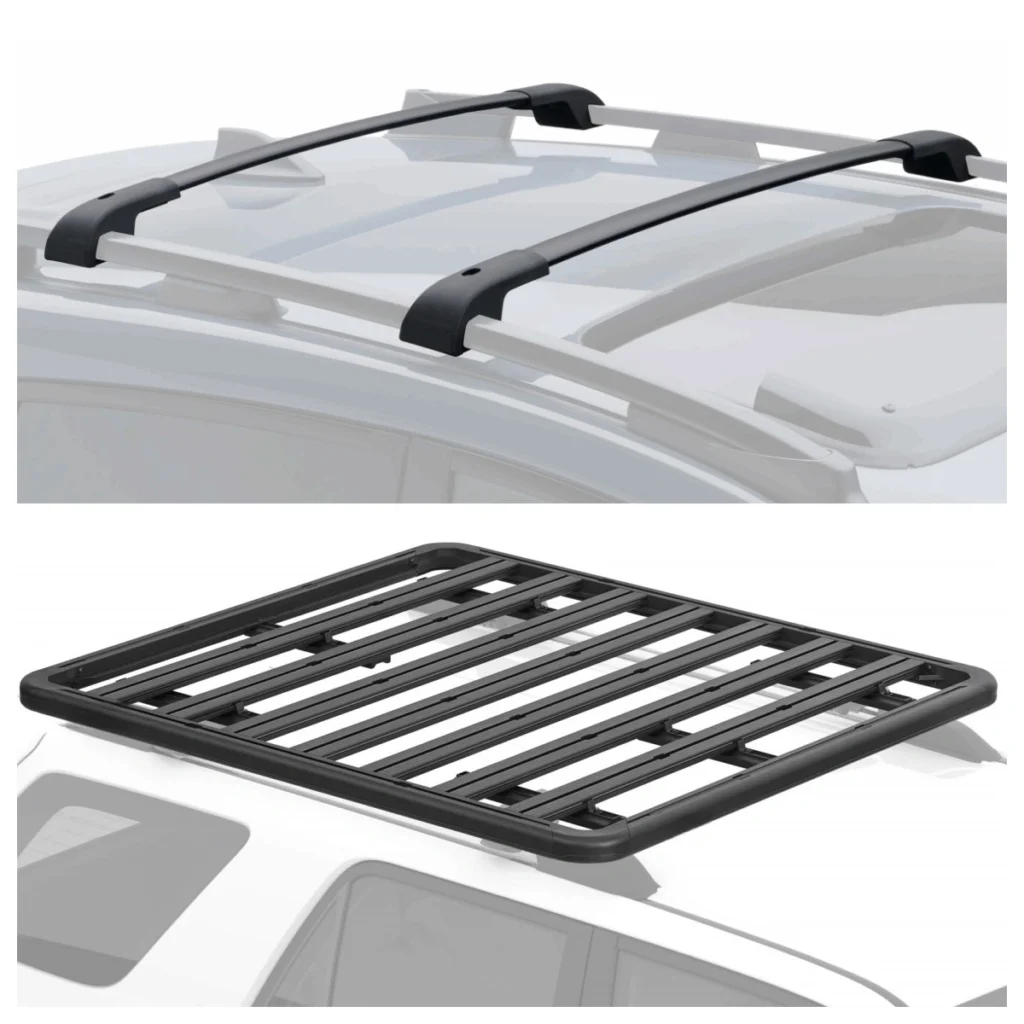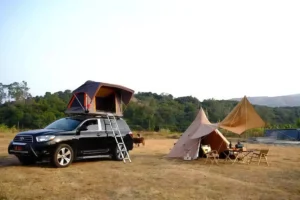When it comes to enhancing your vehicle’s storage and adventure capabilities, choosing the right roof rack is essential. Whether you’re looking to carry camping gear, surfboards, or bikes, a roof rack provides the extra space and convenience you need. But with so many different types and configurations available, how do you know which one is right for your vehicle?
When it comes to enhancing your vehicle’s storage and adventure capabilities, selecting the right roof rack is essential. Whether you’re carrying camping gear, bikes, or a rooftop tent, the correct roof rack system makes all the difference. But with so many options available, how do you know which one suits your vehicle best?
In this guide, we’ll walk you through the different types of vehicle roofs — raised side rails, flush side rails, naked roofs, and fixed points — and how to choose the right roof rack for each. We’ll also provide recommendations for popular SUVs like the Toyota 4Runner, Toyota Highlander, Jeep Wrangler, and Ford Explorer, and explain how roof dimensions and rack types — such as crossbars and platforms — affect your choices. For truck owners, we’ll discuss bed racks and bed crossbars for pickups like the Toyota Tacoma and Ford F-150.
Understanding Your Car's Roof Type

Your roof type plays a key role in determining the right rack system for your vehicle. Let’s break down the four main types of roofs and the vehicle models they correspond to:
Raised Side Rails
Raised side rails are elevated from the roof of the vehicle and run parallel to the car’s length. These rails offer excellent support for attaching a roof rack and make it easy to mount crossbars or platform racks.
- Appearance: Elevated rails that run along the roof edges, creating a gap between the rails and the car roof.
- Compatible Models:
Toyota 4Runner
Toyota Highlander
Ford Explorer
Honda Pilot
Flush Side Rails
Flush side rails sit level with the car’s roofline, blending seamlessly with the vehicle’s design. They’re more aesthetic but may require more effort when installing a roof rack. Still, a wide variety of options exist that are compatible with this roof style.
- Appearance: Rails integrated into the car’s roof, flush with the surface.
- Compatible Models:
Jeep Grand Cherokee
Honda CR-V
BMW X5
Volvo XC90
Naked Roof
A naked roof has no rails or mounting points, requiring a custom rack system that fits directly onto the vehicle’s roof. If you own a vehicle with a naked roof, you’ll need a rack that comes with a mounting kit or uses a clamp system.
- Appearance: No visible rails or mounting points on the roof.
- Compatible Models:
Jeep Wrangler (without rails)
Mazda CX-5
BMW X3
Ford Escape
Fixed Points
Fixed points are pre-installed, factory-made mounting points in the car’s roof that allow you to install a roof rack directly into the structure of the vehicle. These provide a secure, permanent option for carrying heavy loads.
- Appearance: Small mounting points along the roof, often circular or square, designed for rack installation.
- Compatible Models:
Toyota Land Cruiser
Audi Q7
BMW X6
Choosing the Right Roof Rack for Your Vehicle
Once you’ve determined your roof type, it’s time to choose the right rack system based on your needs. Here’s a breakdown of which roof racks are best suited for each vehicle roof type:
Crossbars
Crossbars are one of the most common and versatile roof rack types. They are ideal for carrying lightweight gear like bikes, skis, kayaks, or cargo boxes. However, with the increasing needs in the market, crossbars are able to load heavy items like rooftop tent. Crossbars are easy to install and can be adjusted to fit a variety of roof types.
- Recommended for: Raised Side Rails and Flush Side Rails with typical width dimensions of 47-55 inches.
- Popular Models:
Toyota 4Runner (Raised Side Rails)
Jeep Wrangler (Flush Side Rails)
Toyota Highlander (Raised Side Rails)
For these SUVs, the crossbar length will typically range between 40-55 inches, depending on the width of the car’s roof.
Platform Racks
Platform racks provide a larger, solid surface across the width of the vehicle’s roof, making them ideal for carrying large or heavy items like rooftop tents, oversized cargo, or off-road equipment. They offer increased stability and are a better option for those who need more than just a basic crossbar system. If you are going to mount a platform, make sure you remove the original rails.
- Best For: Heavy-duty use, carrying large or bulky items like rooftop tents, luggage boxes, or off-road gear.
- Popular Models:
Toyota 4Runner
Toyota Land Cruiser
Ford Bronco
Jeep Wrangler
For these vehicles, platform rack dimensions vary based on the roof width and length. For example, platform racks for the Toyota Land Cruiser typically range from 49 to 56 inches in width, with varying lengths depending on the platform size.

Pickup Trucks: Bed Racks and Bed Crossbars
For pickup truck owners, bed racks and bed crossbars offer a unique solution for carrying gear in the truck bed. These racks are ideal for hauling large items like ladders, surfboards, and camping equipment, without taking up valuable space in the truck bed itself.
Bed Racks
Bed racks are mounted on the truck bed itself and are ideal for carrying taller items or heavier loads. When choosing a bed rack, it’s important to consider the height and length, ensuring it accommodates your gear.
- Recommended for: Large, heavy items such as off-road gear, camping gear, or ladders.
- Recommeded Models:
Toyota Tacoma
Ford F-150
The bed rack height typically ranges from 8 to 20 inches, depending on the style and how much clearance you need for larger items.
Bed Crossbars
Bed crossbars are mounted across the width of the truck bed and are excellent for securing smaller loads, such as skis, bikes, or cargo boxes.
- Best For: Smaller, lighter loads that need a stable and secure mount.
- Recommeded Models:
Toyota Tacoma
Ford F-150
The length of bed crossbars typically varies between 48-70 inches, depending on the truck’s bed size. For example, the Toyota Tacoma (5′ bed) would need crossbars that are about 56-62 inches, while the Ford F-150 (6.5′ bed) would require crossbars between 60-70 inches.

Conclusion
Choosing the right roof rack for your vehicle depends on a variety of factors, including your vehicle’s roof type, intended load, and the gear you plan to carry. For SUVs with raised side rails, flush side rails, naked roofs, or fixed points, options like crossbars and platform racks offer versatility and stability for your gear. Pickup truck owners with beds can benefit from bed racks and bed crossbars, which offer solutions for carrying larger items while maximizing bed space.
Whether you’re driving a Toyota 4Runner, a Jeep Wrangler, or a Ford F-150, selecting the right roof or bed rack system ensures a smooth, secure adventure every time.
Let me know if you need further customization or additional recommendations for your specific vehicle model!





9 Comments
Your article helped me a lot, is there any more related content? Thanks!
Yes sure we will write more about the roof rack content!
Your point of view caught my eye and was very interesting. Thanks. I have a question for you.
Yes please, what can we help for you?
Can you be more specific about the content of your article? After reading it, I still have some doubts. Hope you can help me.
Your article helped me a lot, is there any more related content? Thanks!
Can you be more specific about the content of your article? After reading it, I still have some doubts. Hope you can help me.
Thank you for your sharing. I am worried that I lack creative ideas. It is your article that makes me full of hope. Thank you. But, I have a question, can you help me?
Thanks for sharing. I read many of your blog posts, cool, your blog is very good.